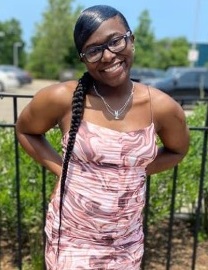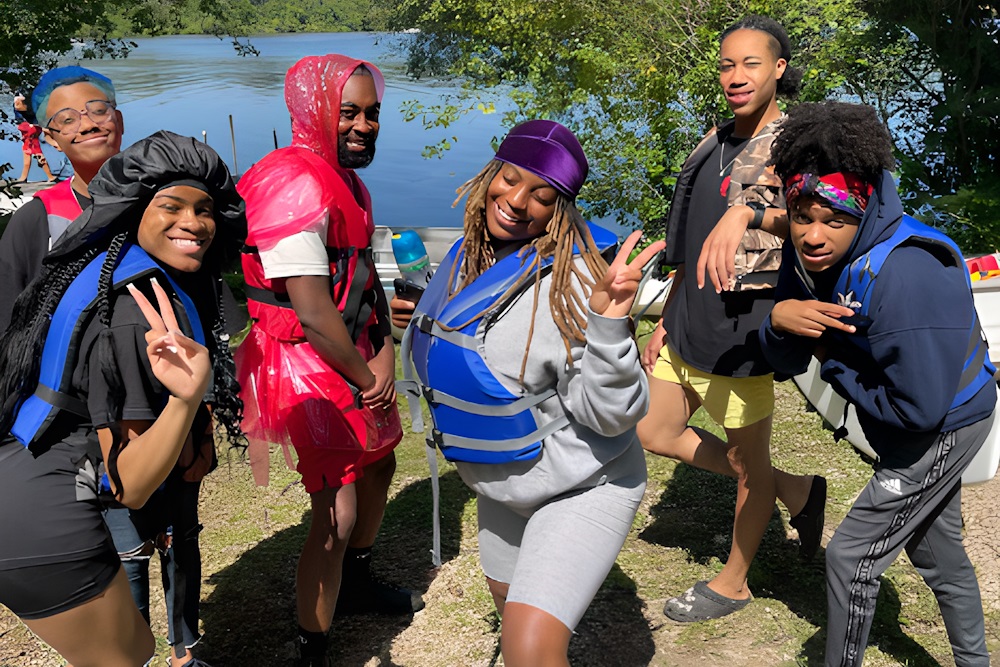Coming of age in a family where she didn’t feel she was supported emotionally, Makaya Massey said that, by the time she was 15, she lacked the confidence to receive a compliment from those who told her she was pretty or smart or worthy of good things. Her insecurities made it difficult for her to trust people.
But all of that started to change after Massey, for a writing assignment in her high school English class, walked through the doors at the Chicago Freedom School. She was so impressed with how that now 16-year-old school was engaging its 14- to 17-year-old participants, she decided she would do more than just write about its work. She enrolled as one of its students, joining its Freedom Fellowship, a six-month social justice and juvenile justice leadership training for youth aiming to become community activists and organizers.

Courtesy of Makaya Massey
Makaya Massey joined the Chicago Freedom School back in 2018 as a freshman in high school.
Through that freedom school, Massey also got psychological counseling and other support.
“I’m around people who refuse to let me sit in my sadness,” began Massey, now 20, explaining how the program improved her mental health. “It’s beautiful to have the people and resources who are willing to help me.”
The Chicago Freedom School, which runs throughout the year, is part of a current incarnation of freedom schools that first launched in 1964 in Mississippi. This was during a time when Black students were battling to upend southern segregation and racist policies resulting, for example, in four times more Mississippi taxpayer money, back then, being spent to educate white students as Black ones, according to Kristal Clemons, national director of the Children’s Defense Fund’s 174 freedom schools across 29 states.
Centrally, those previous freedom schools sought to erase such discrimination and shape what Black children were learning about their nation, its full history and themselves. Today’s freedom schools operate in cities ranging from Seattle on the West Coast to Miami on the East. Some operate year-round, some seasonally. Some enroll only Black youth, others a racial rainbow of young people.
Varyingly, those schools train youth to be community organizers in areas including voting rights; shore up students or help them further excel academically; and educate students on factual histories of people of color that many don’t hear in their own schools. Students also learn, as examples, about reproductive health issues and about how to develop resilience in the face of trauma, whether in their own homes, at school or elsewhere.
“The original freedom schools … were there to supplement what the schools were not giving to Black children,” said freedom schools national director Clemons.
When freedom schools were first established, up to 3,000 Black students met in 41 Mississippi municipalities. The youth and their instructors gathered in run-down taverns, church basements and backyards of volunteers and supporters of the Student Nonviolent Coordinating Committee, Clemons said.
In retaliation against freedom schools’ education-focused activism, during the so-called Freedom Summer of 1964, white racists bombed at least 50 buildings, arrested over 400, beat 60 and killed six Black people, according to the Wisconsin Historical Society.
As that violence eventually came to an end, the U.S. Congress passed the Civil Rights Act of 1964 and the Voting Rights Act of 1965, facts of history taught in today’s freedom schools.
Tailoring freedom schools to meet today’s challenges
Generally, today’s freedom schools tailor their programming to address issues affecting individual communities. For instance, Chicago Freedom School advocates against having police, also known as resource officers, in schools. Its Project Heal Us, a 10-week-long curriculum, explores abortion and other reproductive issues.
The Akwaba Freedom School in Gainesville, Florida, educates students on voting rights and conflict resolution.
“ … it’s also fighting for a just world … ”
Tony Alvarado-Rivera
In Philadelphia, the Center for Black Educator Development, which trains freedom school teachers, also offers high school students after-school instruction and trains them in community organizing and social justice.
“Beyond education, there’s research that’s gone into … the impacts, not just for Black students but for all students, when they have access to a Black teacher or a teacher of color,” said Ansharaye Reyes, content developer at the Philadelphia center, which calls its trainees “servant leaders.”
“Educators who get training through the center,” Reyes added, “are taught how to be culturally responsible to children and their families through their instruction and engagement.”
For instance, the center created a freedom school lesson plan on achieving equity in school funding. The Black educator organization delved into racial disparities in school funding. The group was a part of the campaign that led the Pennsylvania General Assembly to funnel $100 million into the state’s most marginalized school districts to narrow gaps in funding.
The curriculum doesn’t include teaching their participants general school subjects such as math or reading, said Tony Alvarado-Rivera, Chicago Freedom School executive director and a long-time youth worker.
“It’s not just young folks living in their oppression and trauma, it’s also fighting for a just world,” said Alvarado-Rivera. “[CFS] is rooted in movement history.”
That freedom school, Massey said, let her meet like-minded youth and build a peer-to-peer support network aimed not just at helping those who attend the school but also those in her neighborhood. For her part, Massey said she aims to share what she’s learned at Chicago Freedom School with her younger kinfolks.
“I want them to have the tools to fight back for whatever they need. I want to see change,” the 20-year-old said. “Young people do have a voice in things. Our opinion matters.”
***
Tamica Jean-Charles is a Charlottesville, Virginia-based journalist who primarily covers education, family matters and race.




























